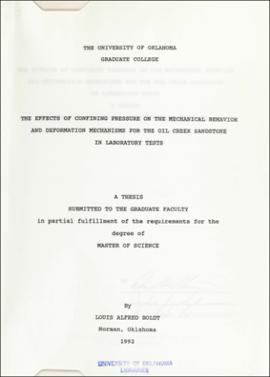| dc.description.abstract | Laboratory rock testing procedures are used to study the effect of confining pressure on the mechanical behavior and deformation mechanisms for the Oil Creek Sandstone: a lightly cemented (quartz), high porosity (~35%) quartz sandstone. Triaxial compression tests are run on room dry samples, at 25 C, and a constant strain rate of 1. 34 x 10- 5sec-1, at confining pressures of 5, 20, 40, 60, 80, 100, 120, and 135 MPa.
Stress-strain curves for the sandstone are derived from
triaxial test data. Indention tests are run on room dry samples, at 25 C, an approximate displacement rate of 1.76X10^-4mm(sec)^-1, and at confining pressures of 44.8 MPa (low) and
124.1 MPa (high). Indention test samples are utilized to study mechanisms by which this sandstone deforms.
Triaxial compression tests illustrate that: 1) the confining pressure at which the boundaries between brittle, transitional, and ductile behavior occurs is higher than for the lower porosity samples tested by Scott and Nielsen (1991), 2) the entire yield surface for Oil Creek Sandstone is delineated over confining pressures encountered in the shallow crust, and 3) porosity is a dominant factor control ling the yield strength of sandstones.
Microscopic observations of both triaxial and indention test samples reflect several types of grain fracturing. Brittle behavior is characterized by grain-contact microfractures that parallel the load axis. Slip along a shear fracture plane is required to produce an extreme reduction in grain size. Transitional behavior is divided into two categories. Category 1, associated with the lower boundary of transitional behavior, is similar to brittle behavior (an abundance of grain-contact microfractures parallel to the load axis with only a small percentage of fine particles). In category 2, associated with the upper boundary of transitional
behavior, grain-contact microfractures parallel to the load axis are present, but fewer in number and there is a substantial increase in the percentage of fine particles. The increase in fine particles, however, is not a function of slip as is the case in the brittle domain. Ductile behavior is characterized by grain contact microfractures that do not show a preferred orientation.
Indention tests illustrate two modes of grain fracturing. Mode 1 is simply grain-contact microfractures. Mode 2, on the other hand, is another type of grain fracturing that polygonizes the grain into randomly oriented, small fragments. In low confining pressure tests, there is a spatial relationship between the indenter, the amount of indention, and growth and development of a zone of mode 2 grain fracturing.
Some of the textures developed, and genesis of the textures, in triaxial and indention test are similar to natural deformation bands. The texture associated with the brittle domain, after visible slip along a shear fracture occurs, is somewhat similar to natural deformation bands. However, in natural deformation bands, this same texture is produced with only minuscule displacement. The texture of category 2 in transitional behavior is also similar to natural deformation bands and, like natural deformation bands, extreme granulation occurs without visible slip. In low pressure indention tests, the texture and development of mode 2 grain fracturing is also similar to natural deformation bands. | |
